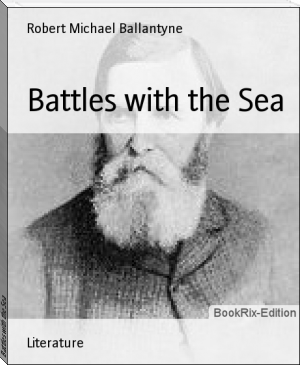Battles with the Sea by Robert Michael Ballantyne (top 100 books of all time checklist txt) 📖

- Author: Robert Michael Ballantyne
Book online «Battles with the Sea by Robert Michael Ballantyne (top 100 books of all time checklist txt) 📖». Author Robert Michael Ballantyne
Every one has heard of Captain Manby's mortar. Its object is to effect communication between a stranded ship and the shore by means of a rope attached to a shot, which is fired over the former. The same end is now more easily attained by a rocket with a light rope, or line, attached to it.
Now the rocket apparatus is a little complicated, and ignorance in regard to the manner of using it has been the cause of some loss of life. Many people think that if a rope can only be conveyed from a stranded ship to the shore, the saving of the crew is comparatively a sure and easy matter. This is a mistake. If a rope--a stout cable-- were fixed between a wreck and the shore, say at a distance of three or four hundred yards, it is obvious that only a few of the strongest men could clamber along it. Even these, if benumbed and exhausted--as is frequently the case in shipwreck--could not accomplish the feat. But let us suppose, still further, that the vessel rolls from side to side, dipping the rope in the sea and jerking it out again at each roll, what man could make the attempt with much hope of success, and what, in such circumstances, would become of women and children?
More than one rope must be fixed between ship and shore, if the work of saving life is to be done efficiently. Accordingly, in the rocket apparatus there are four distinct portions of tackle. First the _rocket-line_; second, the _whip_; third, the _hawser_; and, fourth, the _lifebuoy_--sometimes called the sling-lifebuoy, and sometimes the breeches-buoy.
The rocket-line is that which is first thrown over the wreck by the rocket. It is small and light, and of considerable length--the extreme distance to which a rocket may carry it in the teeth of a gale being between three and four hundred yards.
The whip is a thicker line, rove through a block or pulley, and having its two ends spliced together without a knot, in such a manner that the join does not check the running of the rope through the pulley. Thus the whip becomes a double line--a sort of continuous rope, or, as it is called, an "endless fall," by means of which the lifebuoy is passed to and fro between the wreck and shore.
The hawser is a thick rope, or cable, to which the lifebuoy is suspended when in action.
The lifebuoy is one of those circular lifebuoys--with which most of us are familiar--which hang at the sides of steamers and other vessels, to be ready in case of any one falling overboard. It has, however, the addition of a pair of huge canvas breeches attached to it, to prevent those who are being rescued from slipping through.
Let us suppose, now, that a wreck is on the shore at a part where the coast is rugged and steep, the beach very narrow, and the water so deep that it has been driven on the rocks not more than a couple of hundred yards from the cliffs. The beach is so rocky that no lifeboat would dare to approach, or, if she did venture, she would be speedily dashed to pieces--for a lifeboat is not _absolutely_ invulnerable! The coastguardsmen are on the alert. They had followed the vessel with anxious looks for hours that day as she struggled right gallantly to weather the headland and make the harbour. When they saw her miss stays on the last tack and drift shoreward, they knew her doom was fixed; hurried off for the rocket-cart; ran it down to the narrow strip of pebbly beach below the cliffs, and now they are fixing up the shore part of the apparatus. The chief part of this consists of the rocket-stand and the box in which the line is coiled, in a peculiar and scarcely describable manner, that permits of its flying out with great freedom.
While thus engaged they hear the crashing of the vessel's timbers as the great waves hurl or grind her against the hungry rocks. They also hear the cries of agonised men and women rising even above the howling storm, and hasten their operations.
At last all is ready. The rocket, a large one made of iron, is placed in its stand, a _stick_ and the _line_ are attached to it, a careful aim is taken, and fire applied. Amid a blaze and burst of smoke the rocket leaps from its position, and rushes out to sea with a furious persistency that even the storm-fiend himself is powerless to arrest. But he can baffle it to some extent--sufficient allowance has not been made for the force and direction of the wind. The rocket flies, indeed, beyond the wreck, but drops into the sea, a little to the left of her.
"Another--look alive!" is the sharp order. Again the fiery messenger of mercy leaps forth, and this time with success. The line drops over the wreck and catches in the rigging. And at this point comes into play, sometimes, that ignorance to which I have referred--culpable ignorance, for surely every captain who sails upon the sea ought to have intimate acquaintance with the details of the life-saving apparatus of every nation. Yet, so it is, that some crews, after receiving the rocket-line, have not known what to do with it, and have even perished with the means of deliverance in their grasp. In one case several men of a crew tied themselves together with the end of the line and leaped into the sea! They were indeed hauled ashore, but I believe that most, if not all, of them were drowned.
Those whom we are now rescuing, however, are gifted, let us suppose, with a small share of common sense. Having got hold of the line, one of the crew, separated from the rest, signals the fact to the shore by waving a hat, handkerchief, or flag, if it be day. At night a light is shown over the ship's side for a short time, and then concealed. This being done, those on shore make the end of the line fast to the _whip_ with its "tailed-block" and signal to haul off the line. When the whip is got on board, a _tally_, or piece of wood, is seen with white letters on a black ground painted on it. On one side the words are English--on the other French. One of the crew reads eagerly:--
"Make the tail of the block fast to the lower mast well up. If masts are gone, then to the best place you can find. Cast off the rocket-line; see that the rope in the block runs free, and show signal to the shore."
Most important cautions these, for if the tail-block be fastened too low on the wreck, the ropes will dip in the water, and perhaps foul the rocks. If the whip does not run free in the block it will jamb and the work will be stopped; and, if the signals are not attended to, the coastguardsmen may begin to act too soon, or, on the other hand, waste precious time.
But the signals are rightly given; the other points attended to, and the remainder of the work is done chiefly from the shore. The men there, attach the hawser to the whip, and by hauling one side thereof in, they run the other side and the hawser out. On receiving the hawser the crew discover another _tally_ attached to it, and read:--
"Make this hawser fast about two feet above the tail-block. See all clear, and that the rope in the block runs free, and show signal to the shore."
The wrecked crew are quick as well as intelligent. Life depends on it! They fasten the end of the hawser, as directed, about two feet _above_ the place where the tail-block is fixed to the stump of the mast. There is much shouting and gratuitous advice, no doubt, from the forward and the excited, but the captain and mate are cool. They attend to duty and pay no regard to any one.
Signal is again made to the shore, and the men of the coastguard at once set up a triangle with a pendent block, through which the shore-end of the hawser is rove, and attached to a double-block tackle. Previously, however, a block called a "traveller" has been run on to the hawser. This block travels on and _above_ the hawser, and from it is suspended the lifebuoy. To the "traveller" block the whip is attached; then the order is given to the men to haul, and away goes the lifebuoy to the wreck, run out by the _men on shore_.
When it arrives at the wreck the order is, "Women first." But the women are too terrified, it may be, to venture. Can you wonder? If you saw the boiling surf the heaving water, the roaring and rushing waves, with black and jagged rocks showing here and there, over which, and partly through which, they are to be dragged, you would respect their fears. They shrink back: they even resist. So the captain orders a 'prentice boy to jump in and set them the example. He is a fine, handsome boy, with curly brown hair and bright black eyes. He, too, hesitates for a moment, but from a far different motive. If left to himself he would emulate the captain in being that proverbial "last man to quit the wreck," but a peremptory order is given, and, with a blush, he jumps into the bag, or breeches, of the buoy, through which his legs project in a somewhat ridiculous manner. A signal is then made to the shore. The coastguardsmen haul on the whip, and off goes our 'prentice boy like a seagull. His flight is pretty rapid, considering all things. When about half-way to land he is seen dimly in the mist of spray that bursts wildly around and over him. Those on the wreck strain their eyes and watch with palpitating hearts. The ship has been rolling a little. Just then it gives a heavy lurch shoreward, the rope slackens, and down goes our 'prentice boy into the raging sea, which seems to roar louder as if in triumph! It is but for a moment, however. The double-block tackle, already mentioned as being attached to the shore-end of the hawser, is manned by strong active fellows, whose duty it is to ease off the rope when the wreck rolls seaward, and haul it in when she rolls shoreward, thus keeping it always pretty taut without the risk of snapping it.
A moment more and the 'prentice is seen to emerge from the surf like a true son of Neptune; he is seen also, like a true son of Britain, to wave one hand above his head, and faintly, through driving surf and howling gale, comes a cheer. It is still more faintly replied to by those on the wreck, for in his progress the boy is hidden for a few seconds by the leaping spray; but in a few seconds more he is seen struggling among the breakers on the beach. Several strong men are seen to join hands and advance to meet him. Another moment, and he is safe on shore, and a fervent "Thank God!" bursts from the wrecked crew, who seem to forget themselves for a
 Have you ever thought about what fiction is? Probably, such a question may seem surprising: and so everything is clear. Every person throughout his life has to repeatedly create the works he needs for specific purposes - statements, autobiographies, dictations - using not gypsum or clay, not musical notes, not paints, but just a word. At the same time, almost every person will be very surprised if he is told that he thereby created a work of fiction, which is very different from visual art, music and sculpture making. However, everyone understands that a student's essay or dictation is fundamentally different from novels, short stories, news that are created by professional writers. In the works of professionals there is the most important difference - excogitation. But, oddly enough, in a school literature course, you don’t realize the full power of fiction. So using our website in your free time discover fiction for yourself.
Have you ever thought about what fiction is? Probably, such a question may seem surprising: and so everything is clear. Every person throughout his life has to repeatedly create the works he needs for specific purposes - statements, autobiographies, dictations - using not gypsum or clay, not musical notes, not paints, but just a word. At the same time, almost every person will be very surprised if he is told that he thereby created a work of fiction, which is very different from visual art, music and sculpture making. However, everyone understands that a student's essay or dictation is fundamentally different from novels, short stories, news that are created by professional writers. In the works of professionals there is the most important difference - excogitation. But, oddly enough, in a school literature course, you don’t realize the full power of fiction. So using our website in your free time discover fiction for yourself. 




Comments (0)